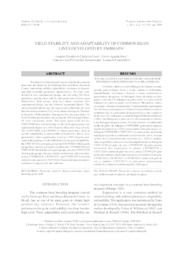Yield stability and adaptability of common bean lines developed by Embrapa.
Yield stability and adaptability of common bean lines developed by Embrapa.
Author(s): COSTA, J. G. C. da; RAVA, C. A.; ZIMMERMANN, F. J. P.; MELO, L. C.
Summary: The objective of this research was to evaluate the common bean lines developed by the Embrapa Rice and Beans Research Center, concerning stability, adaptability, resistance to diseases and other desirable agronomic characteristics. The lines were divided in two experimental groups, one including 216 blackgrain lines, and the other with 56 color grain lines (Carioca and Mulatinho), both groups with four check varieties. The experimental design was the Federer's augmented blocks. The environmental indexes (Ij), the regression coefficients (bi), and their deviation variances (s2di) were obtained using the Eberhart & Russell's (1966) method. Among the 56 color grain lines, 40 showed stable performance, and among the 216 black grain lines,49 were considered stable. The mean grain yield for theCNFP10080 line, which belongs to the black grain group, was significantly higher (p < 0.05) than the Diamante Negro check. The CNFP10099 and CNFP10123 black grain lines showed specific adaptability to unfavorable environments, that is, they presented bi values significantly lower (p < 0.05) than the unit. Among the genotypes with stable behavior and good adaptability,the CNFC10276 (color grain group) and CNFP10207 (black grain group) lines showed good plant architecture; CNFM10258 andCNFC10283 (both from color grain group), and also CNFP10229(black grain group) showed suitable architecture and resistance to rust; CNFM10249, CNFM10251, and CNFM10253 (all with colored seed), and also CNFP10212 (black seed) presented joint resistance to angular leaf spot and rust.
Publication year: 2008
Types of publication: Journal article
Unit: Embrapa Rice & Beans
Keywords: Doença, Feijão, Grão, Melhoramento Genético Vegetal, Phaseolus Vulgaris, Produção, Resistência
Observation
Some of Embrapa's publications are published as ePub files. To read them, use or download one of the following free software options to your computer or mobile device. Android: Google Play Books; IOS: iBooks; Windows and Linux: Calibre.
Access other publications
Access the Agricultural Research Database (BDPA) to consult Embrapa's full library collection and records.
Visit Embrapa Bookstore to purchase books and other publications sold by Embrapa.

